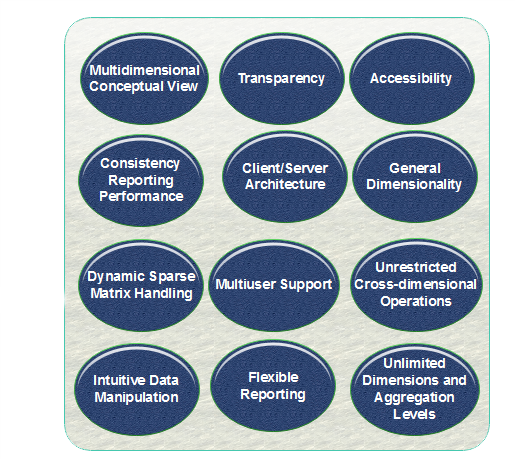What is OLAP (Online Analytical Processing)?OLAP stands for On-Line Analytical Processing. OLAP is a classification of software technology which authorizes analysts, managers, and executives to gain insight into information through fast, consistent, interactive access in a wide variety of possible views of data that has been transformed from raw information to reflect the real dimensionality of the enterprise as understood by the clients. OLAP implement the multidimensional analysis of business information and support the capability for complex estimations, trend analysis, and sophisticated data modeling. It is rapidly enhancing the essential foundation for Intelligent Solutions containing Business Performance Management, Planning, Budgeting, Forecasting, Financial Documenting, Analysis, Simulation-Models, Knowledge Discovery, and Data Warehouses Reporting. OLAP enables end-clients to perform ad hoc analysis of record in multiple dimensions, providing the insight and understanding they require for better decision making. Who uses OLAP and Why?OLAP applications are used by a variety of the functions of an organization. Finance and accounting:
Sales and Marketing
Production
OLAP cubes have two main purposes. The first is to provide business users with a data model more intuitive to them than a tabular model. This model is called a Dimensional Model. The second purpose is to enable fast query response that is usually difficult to achieve using tabular models. How OLAP Works?Fundamentally, OLAP has a very simple concept. It pre-calculates most of the queries that are typically very hard to execute over tabular databases, namely aggregation, joining, and grouping. These queries are calculated during a process that is usually called 'building' or 'processing' of the OLAP cube. This process happens overnight, and by the time end users get to work - data will have been updated. OLAP Guidelines (Dr.E.F.Codd Rule)Dr E.F. Codd, the "father" of the relational model, has formulated a list of 12 guidelines and requirements as the basis for selecting OLAP systems: 
1) Multidimensional Conceptual View: This is the central features of an OLAP system. By needing a multidimensional view, it is possible to carry out methods like slice and dice. 2) Transparency: Make the technology, underlying information repository, computing operations, and the dissimilar nature of source data totally transparent to users. Such transparency helps to improve the efficiency and productivity of the users. 3) Accessibility: It provides access only to the data that is actually required to perform the particular analysis, present a single, coherent, and consistent view to the clients. The OLAP system must map its own logical schema to the heterogeneous physical data stores and perform any necessary transformations. The OLAP operations should be sitting between data sources (e.g., data warehouses) and an OLAP front-end. 4) Consistent Reporting Performance: To make sure that the users do not feel any significant degradation in documenting performance as the number of dimensions or the size of the database increases. That is, the performance of OLAP should not suffer as the number of dimensions is increased. Users must observe consistent run time, response time, or machine utilization every time a given query is run. 5) Client/Server Architecture: Make the server component of OLAP tools sufficiently intelligent that the various clients to be attached with a minimum of effort and integration programming. The server should be capable of mapping and consolidating data between dissimilar databases. 6) Generic Dimensionality: An OLAP method should treat each dimension as equivalent in both is structure and operational capabilities. Additional operational capabilities may be allowed to selected dimensions, but such additional tasks should be grantable to any dimension. 7) Dynamic Sparse Matrix Handling: To adapt the physical schema to the specific analytical model being created and loaded that optimizes sparse matrix handling. When encountering the sparse matrix, the system must be easy to dynamically assume the distribution of the information and adjust the storage and access to obtain and maintain a consistent level of performance. 8) Multiuser Support: OLAP tools must provide concurrent data access, data integrity, and access security. 9) Unrestricted cross-dimensional Operations: It provides the ability for the methods to identify dimensional order and necessarily functions roll-up and drill-down methods within a dimension or across the dimension. 10) Intuitive Data Manipulation: Data Manipulation fundamental the consolidation direction like as reorientation (pivoting), drill-down and roll-up, and another manipulation to be accomplished naturally and precisely via point-and-click and drag and drop methods on the cells of the scientific model. It avoids the use of a menu or multiple trips to a user interface. 11) Flexible Reporting: It implements efficiency to the business clients to organize columns, rows, and cells in a manner that facilitates simple manipulation, analysis, and synthesis of data. 12) Unlimited Dimensions and Aggregation Levels: The number of data dimensions should be unlimited. Each of these common dimensions must allow a practically unlimited number of customer-defined aggregation levels within any given consolidation path.
Next TopicCharacteristics of OLAP
|
 For Videos Join Our Youtube Channel: Join Now
For Videos Join Our Youtube Channel: Join Now
Feedback
- Send your Feedback to [email protected]
Help Others, Please Share










